ML(4)——逻辑回归
Logistic Regression虽然名字里带“回归”,但是它实际上是一种分类方法,“逻辑”是Logistic的音译,和真正的逻辑没有任何关系。
模型
线性模型
由于逻辑回归是一种分类方法,所以我们仍然以最简的二分类为例。与感知机不同,对于逻辑回归的分类结果,y ∈ {0, 1},我们需要找到最佳的hθ(x)拟合数据。
这里容易联想到线性回归。线性回归也可以用于分类,但是很多时候,尤其是二分类的时候,线性回归并不能很好地工作,因为分类不是连续的函数,其结果只能是固定的离散值。设想一下有线性回归得到的拟合曲线hθ(x),当x→∞时,有可能y→∞,这就无法对y ∈ {0, 1}进行有效解释。
对于二分类,逻辑回归的目的是找到一个函数,使得无论x取何值,都有:

满足这个式子的典型函数是sigmoid函数,也称为logistic函数:
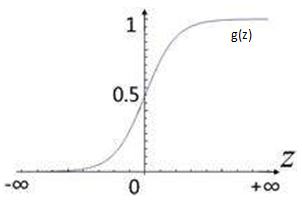
在sigmoid函数g(z)中:
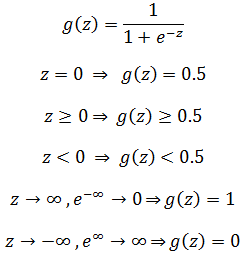
现在,将hθ(x)赋予sigmoid函数g(z)的特性:
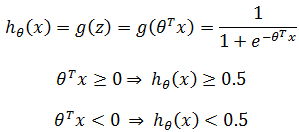
其中:

最终,逻辑回归的模型函数:

假设给定一些输入,现在需要根据逻辑回归模型预测肿瘤是否是良性,最终得到hθ(x) = 0.8,可以用概率表述:

上式表示在当前输入下,y=1的概率是0.8,y=0的概率是0.2,因为是分类,所以判断y = 1。
需要注意的是,sigmoid函数不是样本点的分隔曲线,它表示的是逻辑回归的测结果;θTx才是分隔曲线,它将样本点分为θTx ≥ 0和θTx < 0两部分:

分隔曲线

Sigmoid函数,最终模型
由此看来,逻辑回归的线性模型同样是找到最佳的θ,使两类样本点分离,这就在很大程度上和感知机相似。
多项式模型
直观地看,线性模型的决策边界就是将两类样本点分离开的分隔曲线,我们之前已经多次接触过,只是没有给它起一个专业的名字。假设在一个模型中,hθ(x) = g(θ0 + θ1x1 + θ2x2) = g(-3 + x1 + x2),那么决策边界就是 -3 + x1 + x2 = 0:

很多时候,直线并不能很好地作为决策边界,如下图所示:
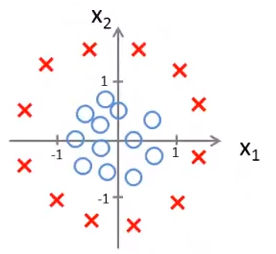
此时需要使用多项式模型添加更多的特征:
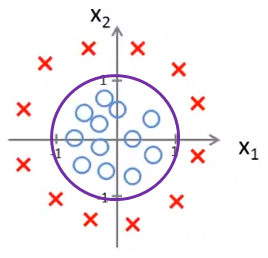

这相当于添加了两个新的特征:

深入了解不同函数的特征有助于选择正确的模型。添加的特征越多,曲线越复杂,对训练样本的拟合度越高,同时也更容易导致过拟合而丧失泛化性:

关于过拟合及其处理,可参考《ML(附录3)——数据拟合和正则化》。
多分类
我们已经知道了二分类的模型,然而实际问题中往往不只是二分类,那么逻辑回归如何处理多分类呢?
一种可行的方法就是化繁为简,将多分类转换为二分类:

如上图所示,三分类转换为三个二分类,其中上标表示分类的类别:
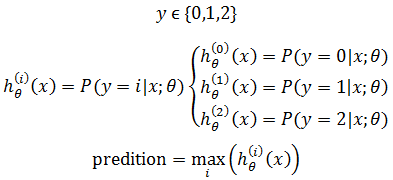
对于输入x,其预测结果是所有hθ(x)中值最大的一个。对于最后的预测结论,以上面的三分类为例,如果输入一个标签为2的特征集,对于hθ(0)(x) 来说,hθ(0)(x) < 0.5:

对于hθ(1)(x) 来说,hθ(1)(x) < 0.5:

对于hθ(3)(x) 来说,hθ(3)(x) ≥ 0.5:

因此,对于输入x,其预测结果是所有hθ(x)中值最大的一个。至于每个样本标签值是多少,无所谓了,在训练每个hθ(i)(x)前,都需要把y(i) 转换为1,其余转换为0。
在上面的图组中也可以看出,对于有k个标签的多分类,需要训练k个不同的逻辑回归模型。
学习策略
在感知机中,模型函数使用了sign,由于sign是阶跃函数,不易优化,所以为了求得损失函数,我们使用函数间隔进行了一系列转换。对于逻辑回归,由于函数本身是连续曲线,所以不会存在这样的问题,其J(θ)使用对数损失函数。对数损失函数的原型:

将其用在逻辑回归上:
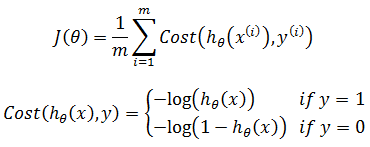
这里的对数是以e为底的对数,即:

注意,0 < hθ(x) < 1。上图是y = 1时的costfunction,可以看到,当hθ(x)→1时,Cost(hθ(x), y)→0;当hθ(x)→0时,Cost(hθ(x),y)→∞。也就是说当分类是1时,sigmoid的值越接近于1,损失值越小;sigmoid的值越接近于0,损失值越大。损失值越大,分类点越接近决策面,其分类越模糊。与此类似,下图是 y = 0时的cost function:
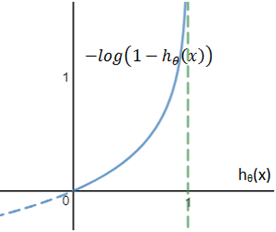
Cost function可以把y = 1和y=1两种情况合并到一起:

理解这种形式需要再次将y分开:
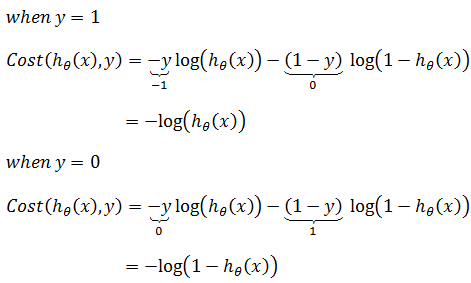
最后得到J(θ)的最终形式:

注意,这里hθ(x)是sigmoid函数:

如果写成矩阵的形式:
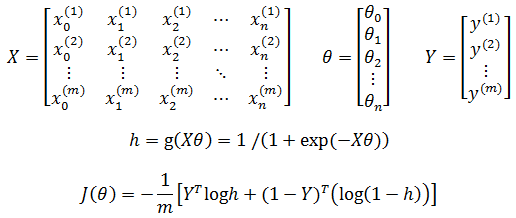
上式中,hθ(x)的操作对应矩阵中的每个元素,1-Y,log hθ(x)也一样,可参照后文的代码实现来理解。
算法
与之前的算法一样,我们的目的是找到最佳的θ使得J(θ)最小化,将求解θ转换为最优化问题,即:

梯度下降
梯度下降是一个适用范围很广的方法,这里同样可以使用梯度下降求解θ:

关于梯度下降的更多内容可参考《ML(附录1)——梯度下降》。
在对J(θ)求偏导时先做一些准备工作,计算sigmoid函数的导数(关于偏导和一元函数的导数,可参考《多变量微积分》和《单变量微积分》的相关章节):
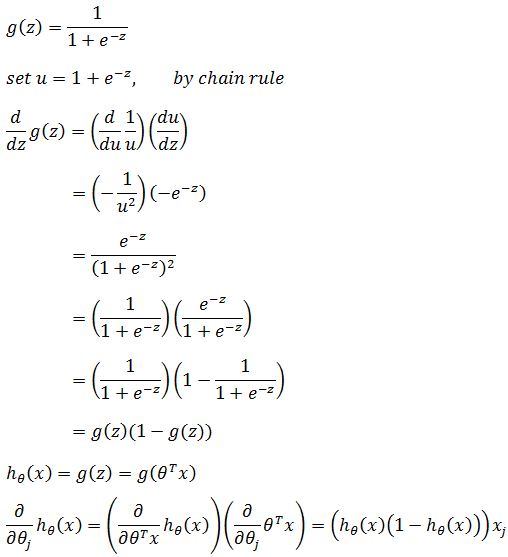
现在计算m=1时J(θ)的偏导,此时可以删除上标:
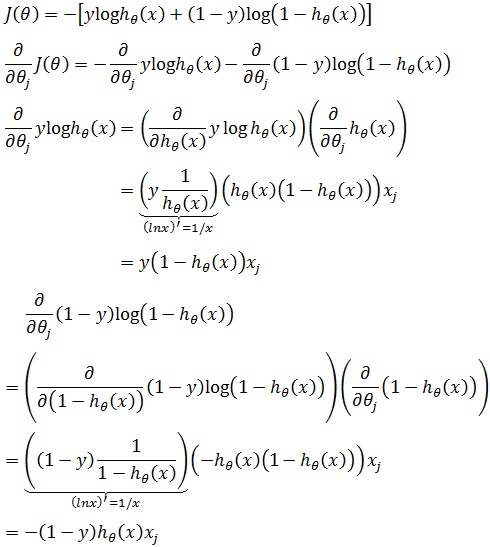

推广到m个样本:

在《机器学习实战》中提到对极大似然数使用梯度上升求最大值,最后得到:

这和对损失函数采用梯度下降求最小值是一样的,因为损失函数使用了似然数的负数形式,Cost(X, Y) = -logP(Y|X),所以对-logP(Y|X)梯度下降和对+logP(Y|X)梯度上升将得到同样的结果。
对于多项式模型,需要预先添加特征,使得每个θj都有唯一的xj对应:

如果用矩阵表示:

在此基础上使用L2正则化(关于正则化,可参考《ML(附录3)——过拟合与欠拟合》):
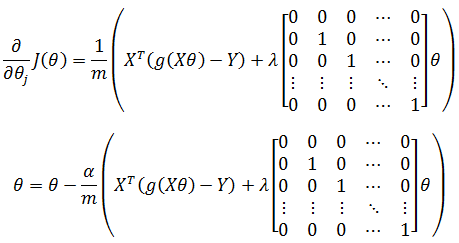
代码实现
ex2data1.txt:
34.62365962451697,78.0246928153624,
30.28671076822607,43.89499752400101,
35.84740876993872,72.90219802708364,
60.18259938620976,86.30855209546826,
79.0327360507101,75.3443764369103,
45.08327747668339,56.3163717815305,
61.10666453684766,96.51142588489624,
75.02474556738889,46.55401354116538,
76.09878670226257,87.42056971926803,
84.43281996120035,43.53339331072109,
95.86155507093572,38.22527805795094,
75.01365838958247,30.60326323428011,
82.30705337399482,76.48196330235604,
69.36458875970939,97.71869196188608,
39.53833914367223,76.03681085115882,
53.9710521485623,89.20735013750205,
69.07014406283025,52.74046973016765,
67.94685547711617,46.67857410673128,
70.66150955499435,92.92713789364831,
76.97878372747498,47.57596364975532,
67.37202754570876,42.83843832029179,
89.67677575072079,65.79936592745237,
50.534788289883,48.85581152764205,
34.21206097786789,44.20952859866288,
77.9240914545704,68.9723599933059,
62.27101367004632,69.95445795447587,
80.1901807509566,44.82162893218353,
93.114388797442,38.80067033713209,
61.83020602312595,50.25610789244621,
38.78580379679423,64.99568095539578,
61.379289447425,72.80788731317097,
85.40451939411645,57.05198397627122,
52.10797973193984,63.12762376881715,
52.04540476831827,69.43286012045222,
40.23689373545111,71.16774802184875,
54.63510555424817,52.21388588061123,
33.91550010906887,98.86943574220611,
64.17698887494485,80.90806058670817,
74.78925295941542,41.57341522824434,
34.1836400264419,75.2377203360134,
83.90239366249155,56.30804621605327,
51.54772026906181,46.85629026349976,
94.44336776917852,65.56892160559052,
82.36875375713919,40.61825515970618,
51.04775177128865,45.82270145776001,
62.22267576120188,52.06099194836679,
77.19303492601364,70.45820000180959,
97.77159928000232,86.7278223300282,
62.07306379667647,96.76882412413983,
91.56497449807442,88.69629254546599,
79.94481794066932,74.16311935043758,
99.2725269292572,60.99903099844988,
90.54671411399852,43.39060180650027,
34.52451385320009,60.39634245837173,
50.2864961189907,49.80453881323059,
49.58667721632031,59.80895099453265,
97.64563396007767,68.86157272420604,
32.57720016809309,95.59854761387875,
74.24869136721598,69.82457122657193,
71.79646205863379,78.45356224515052,
75.3956114656803,85.75993667331619,
35.28611281526193,47.02051394723416,
56.25381749711624,39.26147251058019,
30.05882244669796,49.59297386723685,
44.66826172480893,66.45008614558913,
66.56089447242954,41.09209807936973,
40.45755098375164,97.53518548909936,
49.07256321908844,51.88321182073966,
80.27957401466998,92.11606081344084,
66.74671856944039,60.99139402740988,
32.72283304060323,43.30717306430063,
64.0393204150601,78.03168802018232,
72.34649422579923,96.22759296761404,
60.45788573918959,73.09499809758037,
58.84095621726802,75.85844831279042,
99.82785779692128,72.36925193383885,
47.26426910848174,88.47586499559782,
50.45815980285988,75.80985952982456,
60.45555629271532,42.50840943572217,
82.22666157785568,42.71987853716458,
88.9138964166533,69.80378889835472,
94.83450672430196,45.69430680250754,
67.31925746917527,66.58935317747915,
57.23870631569862,59.51428198012956,
80.36675600171273,90.96014789746954,
68.46852178591112,85.59430710452014,
42.0754545384731,78.84478600148043,
75.47770200533905,90.42453899753964,
78.63542434898018,96.64742716885644,
52.34800398794107,60.76950525602592,
94.09433112516793,77.15910509073893,
90.44855097096364,87.50879176484702,
55.48216114069585,35.57070347228866,
74.49269241843041,84.84513684930135,
89.84580670720979,45.35828361091658,
83.48916274498238,48.38028579728175,
42.2617008099817,87.10385094025457,
99.31500880510394,68.77540947206617,
55.34001756003703,64.9319380069486,
74.77589300092767,89.52981289513276,
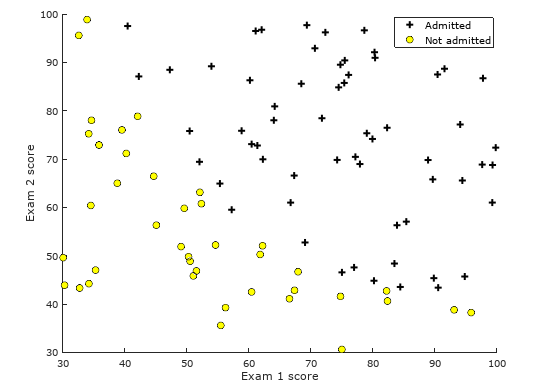
Octave
%% Machine Learning Online Class - Exercise 2: Logistic Regression
%
% Instructions
% ------------
%
% This file contains code that helps you get started on the logistic
% regression exercise. You will need to complete the following functions
% in this exericse:
%
% sigmoid.m
% costFunction.m
% predict.m
% costFunctionReg.m
%
% For this exercise, you will not need to change any code in this file,
% or any other files other than those mentioned above.
% %% Initialization
clear ; close all; clc %% Load Data
% The first two columns contains the exam scores and the third column
% contains the label. data = load('ex2data1.txt');
X = data(:, [1, 2]); y = data(:, 3); %% ==================== Part 1: Plotting ====================
% We start the exercise by first plotting the data to understand the
% the problem we are working with. fprintf(['Plotting data with + indicating (y = 1) examples and o ' ...
'indicating (y = 0) examples.\n']); plotData(X, y); % Put some labels
hold on;
% Labels and Legend
xlabel('Exam 1 score')
ylabel('Exam 2 score') % Specified in plot order
legend('Admitted', 'Not admitted')
hold off; fprintf('\nProgram paused. Press enter to continue.\n');
pause; %% ============ Part 2: Compute Cost and Gradient ============
% In this part of the exercise, you will implement the cost and gradient
% for logistic regression. You neeed to complete the code in
% costFunction.m % Setup the data matrix appropriately, and add ones for the intercept term
[m, n] = size(X); % Add intercept term to x and X_test
X = [ones(m, 1) X]; % Initialize fitting parameters
initial_theta = zeros(n + 1, 1); % Compute and display initial cost and gradient
[cost, grad] = costFunction(initial_theta, X, y); fprintf('Cost at initial theta (zeros): %f\n', cost);
fprintf('Expected cost (approx): 0.693\n');
fprintf('Gradient at initial theta (zeros): \n');
fprintf(' %f \n', grad);
fprintf('Expected gradients (approx):\n -0.1000\n -12.0092\n -11.2628\n'); % Compute and display cost and gradient with non-zero theta
test_theta = [-24; 0.2; 0.2];
[cost, grad] = costFunction(test_theta, X, y); fprintf('\nCost at test theta: %f\n', cost);
fprintf('Expected cost (approx): 0.218\n');
fprintf('Gradient at test theta: \n');
fprintf(' %f \n', grad);
fprintf('Expected gradients (approx):\n 0.043\n 2.566\n 2.647\n'); fprintf('\nProgram paused. Press enter to continue.\n');
pause; %% ============= Part 3: Optimizing using fminunc =============
% In this exercise, you will use a built-in function (fminunc) to find the
% optimal parameters theta. % Set options for fminunc
options = optimset('GradObj', 'on', 'MaxIter', 400);
% Run fminunc to obtain the optimal theta
% This function will return theta and the cost
[theta, cost] = fminunc(@(t)(costFunction(t, X, y)), initial_theta, options);
% Print theta to screen
fprintf('Cost at theta found by fminunc: %f\n', cost);
fprintf('Expected cost (approx): 0.203\n');
fprintf('theta: \n');
fprintf(' %f \n', theta);
fprintf('Expected theta (approx):\n');
fprintf(' -25.161\n 0.206\n 0.201\n'); % Plot Boundary
plotDecisionBoundary(theta, X, y); % Put some labels
hold on;
% Labels and Legend
xlabel('Exam 1 score')
ylabel('Exam 2 score') % Specified in plot order
legend('Admitted', 'Not admitted')
hold off; fprintf('\nProgram paused. Press enter to continue.\n');
pause; %% ============== Part 4: Predict and Accuracies ==============
% After learning the parameters, you'll like to use it to predict the outcomes
% on unseen data. In this part, you will use the logistic regression model
% to predict the probability that a student with score 45 on exam 1 and
% score 85 on exam 2 will be admitted.
%
% Furthermore, you will compute the training and test set accuracies of
% our model.
%
% Your task is to complete the code in predict.m % Predict probability for a student with score 45 on exam 1
% and score 85 on exam 2 prob = sigmoid([1 45 85] * theta);
fprintf(['For a student with scores 45 and 85, we predict an admission ' ...
'probability of %f\n'], prob);
fprintf('Expected value: 0.775 +/- 0.002\n\n'); % Compute accuracy on our training set
p = predict(theta, X); fprintf('Train Accuracy: %f\n', mean(double(p == y)) * 100);
fprintf('Expected accuracy (approx): 89.0\n');
fprintf('\n');
plotData.m
function plotData(X, y)
%PLOTDATA Plots the data points X and y into a new figure
% PLOTDATA(x,y) plots the data points with + for the positive examples
% and o for the negative examples. X is assumed to be a Mx2 matrix. % Create New Figure
figure; hold on; % Instructions: Plot the positive and negative examples on a
% 2D plot, using the option 'k+' for the positive
% examples and 'ko' for the negative examples.
pos = find(y==1); neg = find(y == 0); plot(X(pos, 1), X(pos, 2), 'k+','LineWidth', 2, 'MarkerSize', 7);
plot(X(neg, 1), X(neg, 2), 'ko', 'MarkerFaceColor', 'y', 'MarkerSize', 7); hold off; end
sigmoid.m
function g = sigmoid(z)
%SIGMOID Compute sigmoid function
% g = SIGMOID(z) computes the sigmoid of z. % You need to return the following variables correctly
g = ones(size(z)) ./ (1 + exp(-1 * z)); end
costFunction.m
function [J, grad] = costFunction(theta, X, y)
%COSTFUNCTION Compute cost and gradient for logistic regression
% J = COSTFUNCTION(theta, X, y) computes the cost of using theta as the
% parameter for logistic regression and the gradient of the cost
% w.r.t. to the parameters. % Initialize some useful values
m = length(y); % number of training examples % You need to return the following variables correctly
J = 0;
grad = zeros(size(theta)); % Instructions: Compute the cost of a particular choice of theta.
% You should set J to the cost.
% Compute the partial derivatives and set grad to the partial
% derivatives of the cost w.r.t. each parameter in theta
%
% Note: grad should have the same dimensions as theta
% % % use intrator to compue J
% for i = 1:m
% theta_X = X(i,:) * theta;
% h = 1 / (1 + exp(-1 * theta_X));
% J += y(i) * log(h) + (1 - y(i)) * log(1 - h);
% end
% J /= -1 * m; % use matrix to compute gradient
h = sigmoid(X * theta);
J = (y' * log(h) + (1 - y)' * log(1 - h)) / (-1 * m);
#J /= -1 * m; grad = X' * (h - y) / m;
end
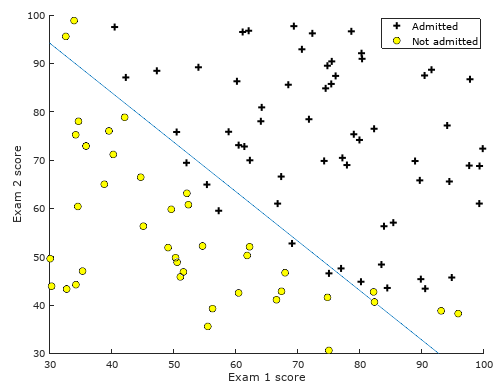
Python
from __future__ import division
import numpy as np
import random
import matplotlib.pyplot as plt def train(X, Y, iterateNum=10000000, alpha=0.003):
'''
:param X: 训练样本的特征集
:param Y: 训练样本的标签
:param iterateNum: 梯度下降的迭代次数
:param alpha: 学习率
:return:theta
'''
m, n = np.shape(X)
theta = np.zeros((n + 1, 1))
# 在第一列添加x0
X_new = np.c_[np.ones(m), X] for i in range(iterateNum):
m = np.shape(X_new)[0]
h = h_function(X_new, theta)
theta -= alpha * (np.dot(X_new.T, h - Y) / m) if i % 100000 == 0:
print('\t---------iter=' + str(i) + ', J(θ)=' + str(J_function(X_new, Y, theta))) print( str(J_function(X_new, Y, theta)))
return theta def h_function(X, theta):
return sigmoid(np.dot(X, theta)) def sigmoid(X):
return 1 / (1 + np.exp(-X )) # 计算J(θ)
def J_function(X, Y, theta):
h = h_function(X, theta)
J_1 = np.dot(Y.T, np.log(h))
J_2 = np.dot(1 - Y.T, np.log(1 - h))
m = np.shape(X)[0]
J = (-1 / m) * (J_1 + J_2) return J def predict(x, theta):
if h_function(x, theta) >= 0.5:
return 1
else:
return 0 # 归一化处理
def normalization(X):
m, n = np.shape(X)
X_new = np.zeros((m, n)) for j in range(n):
max = np.max(X[:,j])
min = np.min(X[:,j])
d_value = max - min
for i in range(m):
X_new[i, j] = (X[i, j] - min) / d_value return X_new def plot_datas(X, Y, theta):
plt.figure() # 绘制分隔直线 g = 0
x1 = [0, 1]
x2 = [(-1 / theta[2]) * (theta[0] + theta[1] * x1[0]),
(-1 / theta[2]) * (theta[0] + theta[1] * x1[1])]
plt.xlabel('x1')
plt.ylabel('x2') plt.plot(x1, x2, color='b') # 绘制数据点
admit_x1, admit_x2 = [],[]
not_admit_x1, not_admit_x2 = [],[]
for i in range(len(X)):
if (Y[i] == 1):
admit_x1.append(X[i][0])
admit_x2.append(X[i][1])
else:
not_admit_x1.append(X[i][0])
not_admit_x2.append(X[i][1]) plt.scatter(admit_x1, admit_x2, color='g')
plt.scatter(not_admit_x1, not_admit_x2, marker='x', color='r') plt.legend(['logistic line', 'Admitted', 'Not admitted'])
plt.show() if __name__ == '__main__':
train_datas = np.loadtxt('ex2data1.txt', delimiter=',')
X = train_datas[:,[0, 1]]
X = normalization(X)
Y = train_datas[:,[2]]
theta = train(X, Y) print(theta)
plot_datas(X, Y, theta)
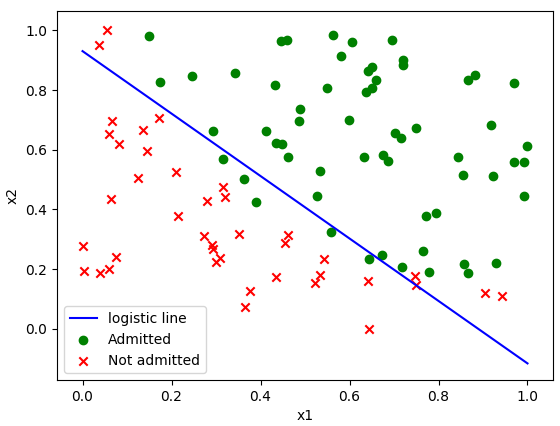
对于样本数据,上面的梯度下降并不是非常有效,无论是否预处理数据(归一化或其他方法),都必须反复调整学习率和迭代次数。如果学习率过大,算法将不会收敛;如果过小,算法收敛的十分缓慢,需要增加迭代次数。代码中的参数最终将使算法收敛于0.203。
Sklearn
from sklearn.linear_model import LogisticRegression
import numpy as np if __name__ == '__main__':
train_datas = np.loadtxt("ex2data1.txt", delimiter=',')
X_train = train_datas[:,[0, 1]]
Y_train = train_datas[:,[2]] logistic = LogisticRegression()
logistic.fit(X_train, Y_train) theta = [logistic.intercept_[0], logistic.coef_[0]]
print(theta)
参考:
Ng视频《Logistic Regression》
周志华《机器学习》
《机器学习导论》
Peter Flach《机器学习》
作者:我是8位的
出处:http://www.cnblogs.com/bigmonkey
本文以学习、研究和分享为主,如需转载,请联系本人,标明作者和出处,非商业用途!
扫描二维码关注公众号“我是8位的”

ML(4)——逻辑回归的更多相关文章
- [机器学习] Coursera ML笔记 - 逻辑回归(Logistic Regression)
引言 机器学习栏目记录我在学习Machine Learning过程的一些心得笔记,涵盖线性回归.逻辑回归.Softmax回归.神经网络和SVM等等.主要学习资料来自Standford Andrew N ...
- 大叔学ML第五:逻辑回归
目录 基本形式 代价函数 用梯度下降法求\(\vec\theta\) 扩展 基本形式 逻辑回归是最常用的分类模型,在线性回归基础之上扩展而来,是一种广义线性回归.下面举例说明什么是逻辑回归:假设我们有 ...
- Spark ML逻辑回归
import org.apache.log4j.{Level, Logger} import org.apache.spark.ml.classification.LogisticRegression ...
- ML 逻辑回归 Logistic Regression
逻辑回归 Logistic Regression 1 分类 Classification 首先我们来看看使用线性回归来解决分类会出现的问题.下图中,我们加入了一个训练集,产生的新的假设函数使得我们进行 ...
- Matlab实现线性回归和逻辑回归: Linear Regression & Logistic Regression
原文:http://blog.csdn.net/abcjennifer/article/details/7732417 本文为Maching Learning 栏目补充内容,为上几章中所提到单参数线性 ...
- Stanford机器学习---第三讲. 逻辑回归和过拟合问题的解决 logistic Regression & Regularization
原文:http://blog.csdn.net/abcjennifer/article/details/7716281 本栏目(Machine learning)包括单参数的线性回归.多参数的线性回归 ...
- Spark机器学习(2):逻辑回归算法
逻辑回归本质上也是一种线性回归,和普通线性回归不同的是,普通线性回归特征到结果输出的是连续值,而逻辑回归增加了一个函数g(z),能够把连续值映射到0或者1. MLLib的逻辑回归类有两个:Logist ...
- Spark LogisticRegression 逻辑回归之建模
导入包 import org.apache.spark.sql.SparkSession import org.apache.spark.sql.Dataset import org.apache.s ...
- pyspark 逻辑回归程序
http://www.qqcourse.com/forum.php?mod=viewthread&tid=3688 [很重要]:http://spark.apache.org/docs/lat ...
随机推荐
- Aimbat安装
1:Pysmo下的sac和aimbat需要放在和前面的toolkits 相同的地方,Python就能找到: 在安装obspy时,需要装yum-plugin-copr; 方法在网址: https://c ...
- aapt获取包名和activity,启动app
1.android sdk的环境安装好了之后,在build-tools\** 的目录下找到aapt.exe,将这个路径设置环境变量,添加到path下 2.在cmdl里面输入:aapt,出现以下内容就是 ...
- L295 how to turn down a job but keep a good relationship with the hiring manager
Let’s say you’re on the hunt for a new job. Three interviews in, you realize it’s not the place for ...
- jetty域证书更新
服务器:centos6.6 1.从正确的.pfx文件中导出.pem认证文件 #openssl pkcs12 -in example.pfx -nodes -out server.pem pfx文件可以 ...
- windwos7 vnc连接centos6.6
一.先配置centos6.6的vnc(已经安装过桌面) #yum install fontforge -y 防止字体乱码 #yum tigervnc tigervnc-server -y ...
- binarysearchtree
public class binarytree<Value> { private Node root = null; private class Node{ private Value v ...
- h5 手机端适配问题汇总
1.uc手机浏览器竟然没有 sessionstorage 醉了 2.opera 浏览器 能识别 a标签中href的 javascript:; 为网址 , 55555 3.safari 的弹框如 ...
- 【Python】基础练习题-1
#练习1:从键盘输入两个数,并比较其大小,直到输入e/E退出程序 while 1: input_number=raw_inut("please input two numbers,enter ...
- 第76课 最小生成树(Prim)
图解: 添加prim函数: #ifndef GRAPH_H #define GRAPH_H #include "Object.h" #include "SharedPoi ...
- BF字符串匹配算法
Brute Force算法是普通的模式匹配算法,BF算法的思想就是将目标串S的第一个字符与模式串T的第一个字符进行匹配,若相等,则继续比较S的第二个字符和 T的第二个字符: 若不相等,则比较S的第二个 ...
